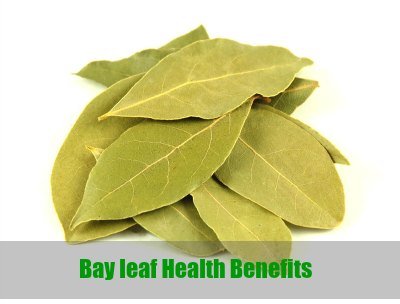HEALTH BENEFITS OF BAY LEAVES
BAY LEAF (LAUREL LEAF)
Pleasantly aromatic bay leaf or bay-laurel is one of the well-recognized culinary leaf-spices in use since the earliest times. In the legends, bay laurel is deemed as the tree of the Sun god, under the celestial sign of Leo.Botanically, bay tree belongs to the family of Lauraceae, in the genus; Laurus. It is thought to have originated in Asia Minor region, from where it distributed to all over the Mediterranean region and other parts of Asia
Scientific name: Laurus nobilis.

Health benefits of bay leaf
--Bay leaf was highly praised by the Greeks and the Romans, who deeply believed that the herb symbolizes wisdom, peace, and protection.--The spice contains many notable plants derived compounds, minerals and vitamins that are essential for optimum health.
--This spice has many volatile active components such as a-pinene, ß-pinene, myrcene, limonene, linalool, methyl chavicol, neral, a-terpineol, geranyl acetate, eugenol, and chavicol. These compounds are known to have been antiseptic, anti-oxidant, digestive, and thought to have anti-cancer properties.
--Fresh leaves are very rich source of vitamin-C; provide 46.5 mg or 77.5% of RDA per 100 g. Vitamin-C (ascorbic acid) is one of the powerful natural anti-oxidant that help remove harmful free radicals from the body. Ascorbic acid also has immune booster, wound healing and anti-viral effects.
--Furthermore, its fresh leaves and herb parts are very good in folic acid; contain about 180 mg or 45% of daily-recommended values per 100 g. Folates are important in DNA synthesis and when given during the peri-conception period, they can help prevent neural tube defects in the baby.
--Bay leaves are an excellent source of vitamin A; contain 6185 IU or 206% of recommended daily levels per 100 g. Vitamin A is a natural antioxidant and is essential for healthy visual sight. It is also required for maintaining mucusa and skin health. Consumption of natural foods rich in vitamin A has been found to help to protect from lung and oral cavity cancers.
--The spice is indeed a very good source of many vitamins such as niacin, pyridoxine, pantothenic acid and riboflavin. These B-complex groups of vitamins help in enzyme synthesis, nervous system function, and regulating body metabolism.
--This noble spice is a good source of minerals like copper, potassium, calcium, manganese, iron, selenium, zinc and magnesium. Potassium is an important component of cell and body fluids that helps control heart rate and blood pressure. Manganese and copper are used by the body as co-factors for the antioxidant enzyme, superoxide dismutase. Iron is essential for red blood cell production and as a co-factor for cytochrome-oxidase enzymes.
Medicinal uses of bay leaf
--Medicinally, the benefits of the bay leaf and its berries are plentiful. It has astringent, diuretic, and appetite stimulant properties.
--Essential oil from the bay leaves contains mostlycineol (50%); furthermore, eugenol, chavicol, acetyl eugenol, methyl eugenol, a- and ß-pinene, phellandrene, linalool, geraniol and terpineol are also found.
--Infusions of herb parts are reputed to soothe stomach ulcers and help relieve flatulence and colic pain.
--The lauric acid in the bay laurel leaves has insect repellent properties.
--The components in the essential oil can also be used in many traditional medicines in the treatment of arthritis, muscle pain, bronchitis and flu-symptoms.
Safety profile
Bay leaves should be removed from the food before serving since they may cause choking, may cut tongue and injure digestive tract. Pregnant women should avoid eating them in excess as the chemical compounds in them may cause abortion.